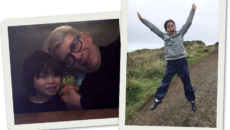An ad. A brochure. A come-on. A notice of product available for transaction, trade, sale. A product. A commodity. Like a used car that’s slightly dinged up, a little older than others, perhaps, but otherwise in fine shape. Ads are appropriate for used cars. But what should you call it when the merchandise on the block is the willingness of your heart? What do you write when what’s at stake is the creation of your family?
Let me backtrack.
My wife and I wanted to have a child. But after four fruitless years in the gristmill of infertility treatments (drugs, inseminations, in vitros, donor eggs), after exhausting our resources (physical, emotional, financial), after burying the monthly hope that our bodies would bring forth children, we accepted the fact that we are infertile. Biology has been quietly put to rest, a haunting memory.
But we still wanted to be parents. We always saw having a family as the next great adventure. So, we turned toward adoption, and as our hearts and spirits began to thaw, adoption filled us with new hope, a sense of possibility we thought still frozen and extinct. We’ll be Mommy and Daddy soon, we told ourselves, just one more gauntlet to run.
After examining our options, we decided to pursue an open adoption. We liked the idea of connecting with our child-to-be’s expectant mother, of having her choose us to parent her child, and of choosing her in return. To find prospective parents, we learned, expectant mothers contact agencies or adoption attorneys, answer classified ads in Sunday newspapers, and, sometimes, surf the Web. Soon they find themselves reviewing what are known as “dear expectant mother letters” (or “dear birth mother letters,” adoption profiles, adoption portfolios, or parent profiles), documents that introduce the adopting couple and explain why they want to adopt. From these, birth mothers narrow their choices.
So we needed to write one, a DEM letter. Quite suddenly, we found ourselves trying to sell ourselves as parents and, just as quickly, realizing the impossibility of the task. Consider for a moment. If I asked you to tell me, with some measure of certainty, what your life will look like in five years, could you do it? Ten years? Eighteen? Will you still be married? Employed in the same profession? Living under similar circumstances? And how will you raise your child? Can you articulate a cogent philosophy governing the stages of life to come? Nanny, day care, or stay-at-home parent? Private school or public? When asked, who can truly predict more than their intention to live, love, thrive, and grow old in the most positive circumstances they can muster? Writing a dear expectant mother letter should be simple, right? “We’re nice people and we’ll do our best. What more can you ask?” Lots, it turns out.
In the early days of open adoption, dear birth mother letters were single-page biographies. But the competition, if you can call it that, has heated up, and the number of prospective parents has grown enormously. For every healthy newborn available, there are now almost forty potential parents searching. Every type of family you can imagine — married, unmarried, and same-sex couples, single women and single men. It seems like everyone wants a baby.
Suddenly, gray pages of typewritten words look dull. After all, expectant mothers live in the same media-saturated world as the rest of us. You have to stand out from the crowd, garner attention, make your pitch.
At first, people enlivened their presentations with a color photo or two. Things quickly escalated. With advances in computer power, digital photography, scanners, and low-cost color printers, these once-simple texts matured (some might say mutated) into well-designed, full-color presentations, corporate prospectuses for WeBeGoodParents Inc.
We were seduced. Both my wife and I have worked in TV advertising, so the process of communicating commercial messages is in our blood. This letter would be our brochure, the come-on to invest in Handels.com. People would buy or pass based on the image we projected, and we resolved to project the best.
We studied dear expectant mother letters written by other couples and analyzed their approaches. How were they targeting the market? We coldly analyzed the “competition” and attempted to position ourselves in the field, capitalizing on our strengths (education, humor, compassion) and smoothing over our weaknesses (Los Angeles, working mom, 40 years old).
We honed our pitch to the perceived interests of the consumer pool, and tried to be all things to all people. Could we be fun yet firm, stable yet fluid, Caucasian yet multicultural, urban but safe, Jewish yet Christian? How could we translate the left-coastal lifestyle of a couple of former artists into an archetypal American home? We’re urban cynics, but the sample letters were lush with what we termed Goo-Goo. Fill your dear expectant mother letter with teddy bears, snuggles, and references to “tummy mommies,” the Goo-Goo school suggested. “Be as cute and cuddly as you can; expectant mothers are suckers for this.” We found it condescending, but to be safe, we spread on some Goo.
Then we chose pictures. Days digging through boxes. My nose? Her hair? What says “great parents” to you? Do we look happy or forced? Approachable or remote? Which picture makes our little house look largest? We even spent a day playing with our best friend’s kids, taking cutesy pictures. Would they help an expectant mother imagine us with children? We considered the subliminal elements and chose a cover photo where our arms formed a heart.
Without really thinking, we ran helter-skelter toward a picture of idealized parents that we believed every birth mother craved. We got high on a sugar rush of pop culture stereotypes, the sweetness of achieving something to overpower the bitter taste of reproductive failure. We would do whatever it took. We could succeed. We would succeed. We must succeed. We…stopped. And took a deep breath.
Our hearts were screaming like sprinters’ nearing the line, but we had been moving too fast to hear them. This wasn’t right. We knew that.
The wonderful thing about writing is that the page becomes a mirror. As you fill it, it reflects all your imperfections, faults, and foibles. Our first drafts showed us an insincerity born of trying to win a game that had beaten us for too many years. We had been infected by the culture; our desire to parent had been transformed into something mercantile. This wasn’t how we would find our child, the one who belongs with us, the one whose family we were meant to be. We were disgusted with ourselves and with the whole proposition.
Suddenly those sample letters we’d read so critically shone with different light. Our hearts went out to the couples just like us, struggling desperately to articulate their innermost yearnings. It wasn’t a competition; it was kinship. And the expectant mothers, we learned, weren’t the indigent teens we had stereotyped, but were of diverse ages, differing education, and varied circumstances. Women who, perhaps in the same sure way we knew we wanted a child, knew, that at this moment, they did not.
We began again. We set out to communicate something authentic, some measure of essential truth about how we are in the world and what we might bring to the life of a child. We tried to put into words our love and longing, our deep, primal desire to raise a family, to witness the growth and flowering of a person and share in his or her life. We embraced anew this imperfect process and struggled to say simply what we desperately felt. We wrote the truth as best we could. In this way, we felt, we would connect with the child we are meant to have. If we weren’t perfect people, well then, so be it. Some open-hearted woman would see us for who we are and entrust her child’s care to our strong circle of love.
But in a culture intoxicated by BabyGap and JonBenet, is it possible to communicate anything as simply held and deeply felt as the urge to parent? Despite our best intentions, our artless letter was colored, photo-retouched, and lasered. It had to, or it wouldn’t look real sitting in our attorney’s stack next to 60 others.
As we handed him the final version, we thought perhaps the medium is no longer the message. If it were, our dear expectant mother letter would be as unadorned as our hearts’ desire. Instead, our message ended up carefully produced to appear as authentic as it is. Though the truth is naked, its messenger went forth clothed in the emperor’s finest.
Postscript: After finishing our dear expectant mother letter, we paid a fee to have it listed among hundreds of others online in an Internet registry. It proved to be the right place for us. Our child’s birth mother, who said she read more than 100 letters online before calling us, told us she liked our sense of humor, our quirky unconventionalism, and our honesty. As we got to know her, we grew to love the same things about her, too. We were there for our son’s birth, and there were lots of smiles, hugs, laughter, and just a few tears to welcome him into the world.


